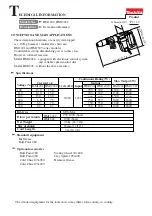
27
6-4. Actual Four-surface Cutting
This section describes some points you should give attention to when performing four-surface cutting.
Effects of Errors in Cutting Accuracy on Finished Results
In four-surface cutting, slight errors in cutting accuracy can affect the finished results. Even errors that have nearly no effect in two-
surface cutting may produce complicated differences in height, wavy cutting marks, or otherwise detract from attractive finished results
for cut surfaces in the case of four-surface cutting.
The cause of unattractive cut surfaces may be, for example, the side of the tool (the outer peripheral tool) damaging the first surface while
performing cutting from the third surface.
When there is absolutely no error in accuracy, the cutting from the third surface should be perfectly flush with the first surface and inflict
no damage on the finished surface. In actual practice, however, eliminating error in accuracy completely is difficult. There may be any
number of possible causes, including mechanical precision, tool wobble, the precision of the tool itself, and deflection of the workpiece.
It is important to reduce errors in cutting accuracy as much as possible, of course, but in actual four-surface cutting, it's also necessary to
take these effects into account.
Examples using unsuitable settings
1
2
1st surface (0˚)
3rd surface (90˚)
The cutting from
the 1st surface
The cutting from
the 3rd surface
The cutting from the
2nd surface
Part 6 Cutting Using MODELA Player ver. 3
* Base object
Errors in cutting
accuracy












































